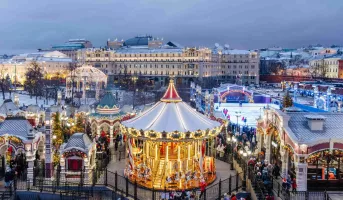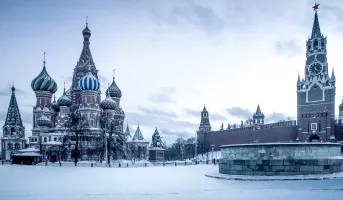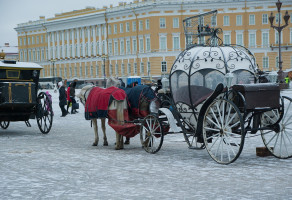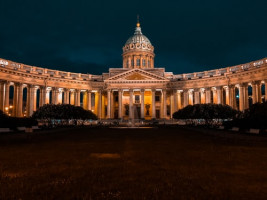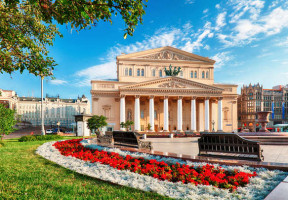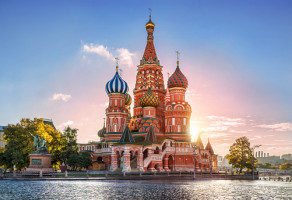St. Petersburg Travel Guide
St. Petersburg, located in Russia, is a city known for its rich history, stunning architecture, and cultural significance. Founded by Peter the Great in 1703, the city served as the imperial capital for two centuries. Its historic center is a UNESCO World Heritage Site, boasting magnificent palaces, cathedrals, and museums. St. Petersburg is famous for being the cultural heart of Russia, with renowned institutions like the Hermitage Museum and Mariinsky Theatre.Top Attractions in St. Petersburg
- Hermitage Museum
- Peter and Paul Fortress
- Church of the Savior on Spilled Blood
- St. Isaac's Cathedral
- Nevsky Prospect
St. Petersburg is Famous for
Imperial palaces, grand cathedrals, and world-class museums.Top Attractions in St. Petersburg
- Explore the opulent Winter Palace
- Take a boat tour along the scenic canals
- Watch a ballet performance at the Mariinsky Theatre
- Visit the Peterhof Palace and Gardens
- Experience the White Nights during summer
What's Great about Travelling to St. Petersburg?
- Rich history and culture
- Architectural marvels
- Art and music scene
- White Nights phenomenon
What's Not So Great about Travelling to St. Petersburg?
- Cold winters
- Language barrier for non-Russian speakers
- Crowds at popular tourist sites
Travel Tips for St. Petersburg
- Obtain a tourist visa before traveling
- Use public transportation or taxis
- Be cautious of pickpockets in crowded areas
Important St. Petersburg trip information
- Ideal Duration: 5-7 days
- Best Time to Visit: May to September
- Nearby Airports and Railway Stations: Pulkovo Airport, Moskovsky Railway Station
Top 13 Places to visit in St. Petersburg
Per Person
69,990
*EXCLUDING APPLICABLE TAXES 4.9 Ratings
( 185 Reviews )
( 185 Reviews )
Per Person
69,990
*EXCLUDING APPLICABLE TAXES 4.9 Ratings
( 185 Reviews )
( 185 Reviews )
Per Person
27,000
*EXCLUDING APPLICABLE TAXES 4.9 Ratings
( 200 Reviews )
( 200 Reviews )
Per Person
44,006
*EXCLUDING APPLICABLE TAXES 4.9 Ratings
( 200 Reviews )
( 200 Reviews )
Per Person
41,047
*EXCLUDING APPLICABLE TAXES 4.9 Ratings
( 200 Reviews )
( 200 Reviews )
Per Person
58,695
*EXCLUDING APPLICABLE TAXES 4.9 Ratings
( 200 Reviews )
( 200 Reviews )
FAQ's on St. Petersburg
Q1: What is the best time to visit St. Petersburg?
St. Petersburg is best visited during the summer months from June to August when the weather is mild and the city comes alive with festivals and events. The White Nights phenomenon in June is a magical experience as the city basks in almost 24 hours of daylight. However, if you prefer fewer crowds and lower prices, consider visiting in the shoulder seasons of spring (April to May) or autumn (September to October).
Q2: Do I need a visa to travel to St. Petersburg?
Yes, most visitors to St. Petersburg will need a visa to enter Russia. However, cruise ship passengers staying for less than 72 hours and travelers from certain countries may be eligible for visa-free entry. It is advisable to check the specific visa requirements based on your nationality and travel plans well in advance.
Q3: What are the must-visit attractions in St. Petersburg?
St. Petersburg boasts a wealth of iconic attractions such as the Hermitage Museum, Winter Palace, Peter and Paul Fortress, Church of the Savior on Spilled Blood, and the grandeur of the State Russian Museum. The Peterhof Palace and Gardens, Catherine Palace in Pushkin, and the Mariinsky Theatre are also must-visit landmarks for culture enthusiasts.
Q4: Is St. Petersburg a safe place to travel?
St. Petersburg is generally a safe city for tourists. Like any major city, it is advisable to stay vigilant against pickpocketing and follow basic safety precautions. Avoid poorly lit areas at night and be cautious in crowded places. It is recommended to keep your belongings secure and be aware of your surroundings.
Q5: What is the local currency in St. Petersburg and can I use credit cards?
The local currency in St. Petersburg, Russia, is the Russian Ruble (RUB). While credit cards are widely accepted in hotels, restaurants, and larger stores, it is advisable to carry cash for smaller establishments and local markets. ATMs are readily available throughout the city for convenient currency exchange.
Q6: What is the local cuisine like in St. Petersburg?
St. Petersburg offers a diverse culinary scene with influences from Russian, European, and Asian cuisines. Must-try dishes include borscht (beet soup), pelmeni (dumplings), blini (pancakes), and traditional Russian salads. Indulge in caviar, smoked fish, and hearty stews for a taste of authentic Russian flavors. Don't miss out on trying local desserts like medovik (honey cake) and pryaniki (spiced gingerbread).
Q7: What transportation options are available in St. Petersburg?
St. Petersburg has an extensive public transportation network including buses, trams, trolleybuses, and the metro system. Taxis and ride-hailing services are also readily available for convenient travel within the city. For exploring attractions outside the city center, consider renting a car or joining guided tours for a hassle-free experience.
Q8: Are there any cultural norms or etiquette I should be aware of when visiting St. Petersburg?
When visiting St. Petersburg, it is important to respect local customs and traditions. Dress modestly when visiting religious sites and remove your hat inside churches. Greet locals with a polite "Zdravstvuyte" (hello) and try to learn a few basic Russian phrases. Avoid discussing sensitive topics like politics and religion unless initiated by the locals. Tipping is customary in restaurants and for good service. Embrace the rich cultural heritage of St. Petersburg with an open mind and respectful attitude.
Q9: I am a travel agent. How can I buy travel leads of St. Petersburg?
Register yourself as a travel agent at agents.tripclap.com and then you can buy travel leads to St. Petersburg once your account is approved. For more details contact our support team at +91-8069186564 or support@tripclap.com
